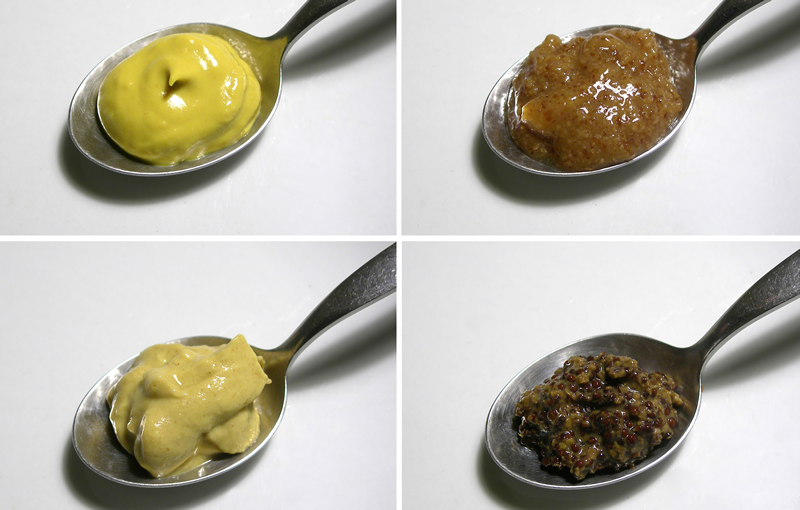The Curse of the Gourmet Mustard

Mustard and the Marginal Economy
I have the good fortune of living next to the top food market in the world: Toronto’s St. Lawrence Market. Every Saturday I troll the market for free samples. It’s possible to skip lunch if you fill yourself up with the cornucopia of free samples available, and among the tastiest of the lot is Kozlik’s mustard. They make over 36 kinds, and you can sample as many as you like.
Kozlik’s is to mustard in Toronto what Schwartz’s is to smoked meat in Montreal or the Anchor Bar is to wings in Buffalo: the reigning king of the category. Knowing this made it all the ballsier when Mrs. McGariggle’s Mustard showed up one Saturday with a little table placed a scant 15 feet away from Kozlik’s, and started offering samples. The nerve!
Hats off to Mrs. McGariggle, however, for having the guts not only to snag mustard.ca, but to beard the mustard lion in his den.
“But wait a second.” I thought, “How many bespoke mustard manufacturers does one world/town/market need?” After all, we’re talking about a marginal product and a niche market. People don’t seek out gourmet mustard in droves: it’s usually an impulse purchase or – more likely – that perennial gift you get someone when you need something unique, small, inexpensive and broadly acceptable to almost anyone’s tastes.
The Lurker in the Fridge
That’s what makes mustard and thousands of other foodstuffs commercially marginal: they’re not staples, and none of them are regular purchases. One jar of fancy mustard will take up residence in your fridge for a very long time. It will probably stick around long enough to become part of the family. You’ll get to know it over the course of a very long lifespan relative to the other denizens of your fridge because you’ll consume it very slowly, as it becomes crusty and dried out over the span of a good six to twelve months. This lifespan makes gourmet mustard something you’ll probably buy very infrequently, which means it’s very difficult for anyone to turn over enough sales of small-batch gourmet mustard to make a living off it.
If that’s the case, why are there so many fancy mustard manufacturers? And bespoke jam makers? And specialty cracker outfits? And niche cheese folk? I can count at least half a dozen kinds of each of those foodstuffs on the shelves of any chi-chi food shop in my neighbourhood. Unfortunately, there aren’t enough chi-chi food shops in the world to support the number of specialty food operations out there, especially since the same suppliers rarely repeat from one store to the next, it seems.
Mustard: Destroyer of Dreams
The answer to this mustardy dilemma is that gourmet foodstuffs are often what happens when entrepreneurs are tempted by high margins on a product, and don’t take volume into account, combined with the allure of a “hobby” business. A hobby business is when you try to turn what you love – usually a part-time passion, hobby or past-time – into a business. Without a hard, honest profit projection, this is a recipe for disaster: the temptation of doing what you love combined with the allure of high margins shunts aside any calculation of sales volume for the niche products typically associated with these businesses.
These products tempt entrepreneurs because they see the margins on such a small food item, and see only the potential. Unfortunately, entrepreneurs are notoriously lousy at math; otherwise, they’d look at the number of units they need to sell to make a decent living from these products, calculate the number of units that need to move through each store per week, multiply that by the number of stores that will stock a given specialty item, and come to the inevitable result that they probably won’t make as much money off gourmet mustard/jam/crackers/cheese as they think they will.
A trip to the local fancy food store won’t show you the history of failed fancy foods that were on the shelves the year before. Impulse buys and Christmas-time desperation purchases – when you can’t figure out what the hell else to get finicky Aunt Judy – only move so much product. This results in the gradual death of untold numbers of niche suppliers. Unfortunately, unless you keep track of what appears and disappears on the shelves of Ye Olde Gourmet Shoppe, you’ll never see that bigger picture.
How to Avoid the Heartbreak of Mustard
The lesson is this: it’s important to differentiate “fun” from “lucrative,” “hobby” from “business,” and “margin” from “revenue.” Doing what you love is admirable, but it doesn’t guarantee a living, and too many niche products begin life as “Gosh, I love doing this and people tell me I’m good at it – I should start a business!” Likewise, margins are lucrative, but not when volume is so low you can’t make a living from them. Too many entrepreneurs are blind to these calculations, which is probably a major contributing factor to 80% of them failing in their first 18 months. So think with your head, not with your heart, before you make that leap into the niche, marginal end of the pool. I have faith that the award-winning Mrs. McGariggle (if that is your real name…) and Mr. Kozlik will be around in five years. I’m not so sure about the legion of other micro-mustarderies. And cheese whizzes. And jammers. And cracker-makers.
Image: https://commons.wikimedia.org/wiki/File:Senf-Variationen_edit2.jpg




